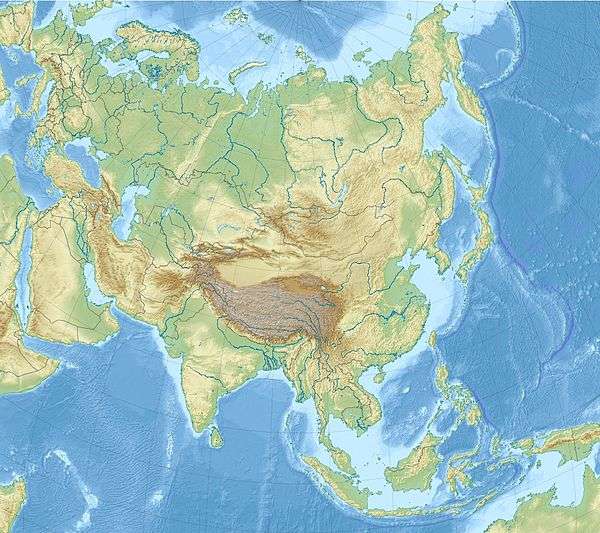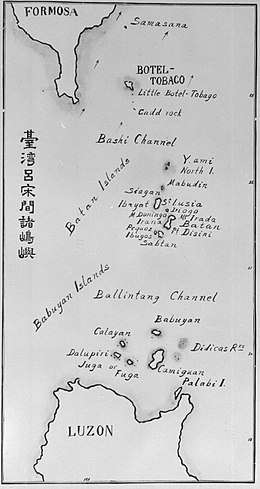Luzon Strait
The Luzon Strait (Filipino: Kipot ng Luzon) is the strait between Taiwan and Luzon island of the Philippines. The strait thereby connects the Philippine Sea to the South China Sea in the western Pacific Ocean.[1][2]
| Luzon Strait | |
|---|---|
 Luzon Strait | |
| Coordinates | |
| Basin countries | Taiwan, Luzon island of the Philippines |
| Max. width | 250 kilometers (160 mi) |
| Max. depth | ca. 4,000 meters (13,000 ft) |

This body of water is an important strait for shipping and communications. Many ships from the Americas use this route to go to important East Asian ports. Many submarine communications cables pass through the Luzon Strait. These cables provide important data and telephony services to China, Hong Kong, Taiwan, Japan and South Korea.[3]
Description
The Luzon Strait is approximately 250 kilometers (160 mi) wide containing a number of islands belonging to the Philippines that are grouped into two: the islands comprising the province of Batanes and the Babuyan Islands, which are part of the province of Cagayan. The strait is divided into a number of smaller channels. The Babuyan Channel separates Luzon from the Babuyan Islands, which is separated from Batanes by the Balintang Channel. Batanes is separated from Taiwan by the Bashi Channel.
Some of the largest ocean waves in the world, at times over 170 meters in height and stemming from tides and ocean currents, are found in the north of the strait. These waves or currents are underwater and rarely break the surface, thus posing no danger to shipping but are sometimes visible to satellites. The oscillation is largely prompted by a long north–south ridge which covers almost all of the strait, then amplified in the northern section by a second parallel ridge.[4] The depth of the strait reaches the 3,500 m and 4,000 contours in north–south trenches in the middle and south-western edge.
History
The Luzon Strait was part of the Japanese invasion route during the Second World War. On 8 December 1941 (the same day as the Japanese attack on Pearl Harbor, due to the International Date Line), forces of the Empire of Japan landed on Batanes. By 10 December, they had occupied Camiguin de Babuyanes in the Babuyan Islands (not to be confused with the island-province of Camiguin off northern Mindanao) in a soon-abandoned attempt to establish a seaplane base, and on the same day landed at Aparri, Cagayan on Luzon.
Subsequently, during the Second World War, many US submarines hunted Japanese convoys passing through the strait on their way from the East Indies to Japan.
References
- "Pacific Ocean". CIA World Factbook. Retrieved on 2011-06-20.
- "Southeast Asia Map" Archived 16 September 2012 at the Wayback Machine. CIA World Factbook. Retrieved on 2011-06-20.
- Greenlees, Donald and Arnold, Wayne (2006-12-29). "Asia scrambles to fix quake damage to data cables". CNET News.com.
- Oskin, Becky (2014-01-09). "Ocean's Huge Hidden Waves Explained"". LiveScience.com. Retrieved on 2014-01-13.
